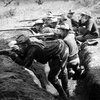someguy2800
Member
After many hours of considering the "ammo conservation" thing... that I just can't get past...
I find it extremely difficult to believe the minor difference in ballistics between the Krag & Mauser was significant enough to matter.
Also a well trained soldier with a Krag rifle Vs one with a Mauser & stripper clip would be a very close match. Especially with the Krag advantage of topping off a magazine with a round chambered!
Admittedly I haven't studied the battle(s) of The Spanish American War, but my gut feeling is something else created the imbalance.
Imagine a scenario where each side switched arms. Would the outcome remain or would it change simply over the weapons? My gut tells me "no".
Success is not only judged by who won the day, but also how many had to die in the process, and I am confident that there would be less dead Americans in Cuba if we had been better equipped with small arms. It also wasn't just the krags that left the Americans fighting an uphill battle (pun intended). The army hadn't even been fully equipped with krags yet. Some troops were deploying with trap door Springfield's still.



